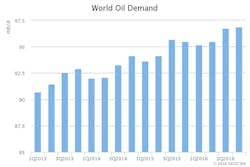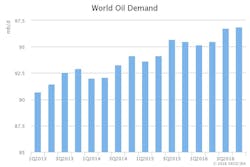In its July Oil Market Report, the International Energy Agency states that the “the market is heading to balance remains on track,” but the road ahead is “far from smooth” as revealed by the recent modest fall back in oil prices.
“The adjustments to our data this month suggest that little has changed with the market showing an extraordinary transformation from a major surplus in the first quarter 2016 to near-balance in the second quarter. In mid-summer 2016, although market balance is upon us, the existence of very high oil stocks is a threat to the recent stability of oil prices,” IEA said.
There are signs that demand growth momentum is easing; and, although stocks are close to topping out, they are at such elevated levels, especially for products for which demand growth is slackening, that they remain a major dampener on oil prices. In this year’s first quarter, as noted by IEA, refinery runs growth was 60% higher than refined product demand growth.
IEA warned that there is a risk that product stocks could rise still further and threaten the whole price structure.
Demand
Estimates for global oil demand in 2016 have been raised to 96.1 million b/d, up 100,000 b/d since last month’s report. This upgrade is largely attributable to Europe’s resilience. A demand growth of 1.4 million b/d is now envisaged in 2016.
European oil consumers offered the biggest 2016 second-quarter demand surprise with preliminary data showing demand rising at a five-quarter high of 240,000 b/d year-on–year. However, according to IEA, this is unlikely to last, with the ongoing precariousness of the European economies now dealing with added uncertainty following the UK vote to exit the European Union.
Official US oil demand data for April fell below expectations, but preliminary May-June demand numbers exceed expectations with manufacturing business sentiment indicators posted surprising midyear optimism.
Chinese demand stuttered severely in May, rising just over 1% on the year earlier, with momentum undermined by particular weakness in gas oil, diesel, and bitumen. China’s previously strong rising demand for gasoline lost steam recently. The rapid growth of Indian demand continues in May, albeit not at the breakneck pace seen in recent months.
Into 2017, IEA forecast global demand to rise a further 1.3 million b/d to 97.4 million b/d, attributable to non-OECD consumers.
Supply
Global oil supplies rose 600,000 b/d in June to 96 million b/d, after outages curbed OPEC and non-OPEC supplied in May. World production was 750,000 b/d below a year-earlier as robust output in the low-cost Middle East was not enough to offset declines elsewhere.
Middle East oil production rose to a record-high of 31.5 million b/d in June, reaching a 35% market share, the highest since the late 1970s.
OPEC crude output rose by 400,000 b/d in June to 33.21 million b/d, including newly rejoined Gabon. Saudi Arabia ramped up to a new record rate of 10.45 million b/d and Nigeria flows partially recovered from rebel attacks. OPEC’s total output is 510,000 b/d above a year ago.
In June, Iran’s oil production was still higher and flows of 3.66 million b/d were up 840,000 b/d on a year ago. By contrast, Venezuela’s oil supply is declining fast, with output in June slipping to 2.18 million b/d, down 240,000 b/d on the previous year.
Non-OPEC oil production is estimated to have increased by 205,000 b/d in June, to 55.9 million b/d, following a partial recovery in Canadian oil production and seasonally higher biofuels output. Total supplies nevertheless stood more than 1.4 million b/d below a year earlier, with notable declines in the US, Canada, China, and Colombia.




